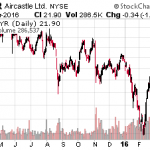Confounding can be an issue when analyzing the association between quantities of money and inflation.  Image by Richard Reid from Pixabay IntroductionPreviously,1 we suggested that two possible examples of confounding existed:
Image by Richard Reid from Pixabay IntroductionPreviously,1 we suggested that two possible examples of confounding existed:
Last week,2 we examined how this confounding might be characterized. The data obtained are summarized in Figure 1.Figure 1. Three Variable Correlations for HNO, NFC, and CPI 1976-80 Previously:
Previously:
- The associations displayed are from the analysis section of this post. They are the largest absolute value associations. The directions of the arrows point from the leading data to the lagging data: The arrow from CPI to HNO indicates that CPI changes preceded HNO changes for that data set.
- The illustration here shows that confounding is possible for associations between quantity of money variables and CPI inflation. However, it does not prove that it happens. We are back to the old adage—correlation does not prove causation.
This week, we offer the following hypothesis:
Expressing the two conditions above with equations:a * Correl (HNO, CPI) + b * Correl (NFC, CPI) = Correl({HNO + NFC}, CPI) + New SA (Eq. 1) a * Correl (HNO, CPI) + b * Correl (NFC, CPI) > Correl({HNO + NFC}, CPI) (Eq. 2)wherea = HNO/(HNO + NFC)b = NFC/(HNO + NFC)SA = Spurious AssociationsEq. 2 is valid when no new spurious associations arise but may not be valid when they do.Note: This is a hypothesis because we have not yet proved the relationships from first principles. It is based on the fact that if there is causation, there must be a correlation. However, correlation can exist without causation (circumstantial or spurious correlation). Stated succinctly, correlation is a necessary but not a sufficient condition for causation. We cannot assume this hypothesis is valid without further analysis. DataThe data used here has been updated as of July 7, 2024. The Fed Fred database is the source for HNO3, NFC4, and CPI.5Table 1 shows the data for HNO, NFNC, the sum of HNO and NFCTable 1. Quarterly Data for HNO + NFC 4Q 1951 – 1Q 2024


 The ratio of each variable to the sum varies in what seems to be a remarkably narrow range over the 72 years. See Figure 2.Figure 2. HNO as a Fraction of HNO + NFC (4Q 1951 to 1Q 2024)
The ratio of each variable to the sum varies in what seems to be a remarkably narrow range over the 72 years. See Figure 2.Figure 2. HNO as a Fraction of HNO + NFC (4Q 1951 to 1Q 2024) This may make it acceptable to use the average ratio for all inflation intervals to be examined. Timeline DataTable 2 below has the data for coincident HNO + NFC and CPI timelines.Table 2. (HNO + NFC) Growth and Inflation (CPI), Coincident Data, 1952-2023*
This may make it acceptable to use the average ratio for all inflation intervals to be examined. Timeline DataTable 2 below has the data for coincident HNO + NFC and CPI timelines.Table 2. (HNO + NFC) Growth and Inflation (CPI), Coincident Data, 1952-2023*
 ConclusionThe timeline offset data will be completed next week, and hopefully, a deeper look at the nature of confounding with HNO, NFC, and CPI will occur. Footnotes1. Lounsbury, John, “Quantity of Money and Inflation. Part 1. General Considerations”, EconCurrents, July 7, 2024. https://econcurrents.com/2024/07/07/quantity-of-money-and-inflation-part-1-general-considerations/.2. Lounsbury, John, “Quantity of Money and Inflation. Part 2. Confounding”, EconCurrents, July 14, 2024. https://econcurrents.com/2024/07/14/quantity-of-money-and-inflation-part-2-confounding/.More By This Author:Quantity of Money and Inflation – Part 1: General ConsiderationsEconomics In America: An Immigrant Economist Explores The Land Of Inequality Jobs Report Sends Indexes Spiraling Downward Closing Fractionally Lower
ConclusionThe timeline offset data will be completed next week, and hopefully, a deeper look at the nature of confounding with HNO, NFC, and CPI will occur. Footnotes1. Lounsbury, John, “Quantity of Money and Inflation. Part 1. General Considerations”, EconCurrents, July 7, 2024. https://econcurrents.com/2024/07/07/quantity-of-money-and-inflation-part-1-general-considerations/.2. Lounsbury, John, “Quantity of Money and Inflation. Part 2. Confounding”, EconCurrents, July 14, 2024. https://econcurrents.com/2024/07/14/quantity-of-money-and-inflation-part-2-confounding/.More By This Author:Quantity of Money and Inflation – Part 1: General ConsiderationsEconomics In America: An Immigrant Economist Explores The Land Of Inequality Jobs Report Sends Indexes Spiraling Downward Closing Fractionally Lower








Leave A Comment